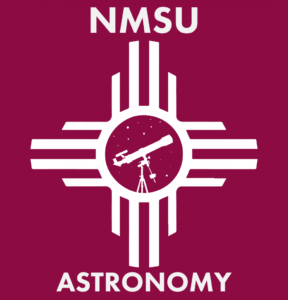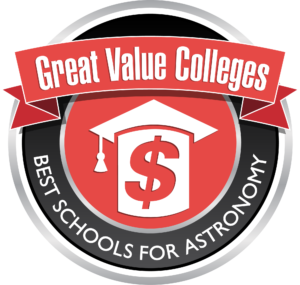Look to the stars, or simply at this list, to find the cheapest, high-quality bachelor degree programs designed to help you become an astronomer.
Because astronomy is an extension of physics, you’ll want to consider the variety of specific degree program types mentioned in this article, like the following:
- BA or BS in Astronomy
- BS in Astrophysics
- BS in Astronomy & Astrophysics
- BA or BS in Physics with an Astrophysics Concentration
- BS or BA in Physics with a Concentration in Astronomy
- BA or BS in Physics with an Emphasis in Astronomy & Astrophysics
- BS in Physics-Astrophysics
- BA and BS in Astronomy-Physics
- BS in Space Systems Engineering
- BS in Physics with an Earth and Planetary Sciences Concentration
- Physics+ Astronomy & Astrophysics
- BS in Astrobiology and Biogeosciences
- BS in Exploration Systems Design
- BS in Earth and Space Exploration
- Introduction to Astronomy Minor
- Astronomy minor
- Astrophysics minor
Just within the last few years, NASA has moved closer to answering the big question: Is there life in space, and where is it? If this piques your interest, it’s time you channel your inner Stephen Hawking (a student of physics and cosmology) and become an astronomy major.
With an undergraduate astronomy degree, you will be prepared to enter graduate study in astronomy, astrophysics and other related subjects. However, if graduate school isn’t on your horizon, these bachelor degree programs will set you up for a future of working as a research scientist or director of planetariums and observatories, among other careers (listed toward the end of this article).
If you love science but are hesitant to put all of your eggs into the astronomy basket, don’t fret. Almost all of the degree programs listed below, especially the BA degrees, are transferable. This means they can create an avenue for you to enter a variety of career fields, like:
- business
- technology
- education
- law
- government
- communications and more
Still, you’ll want to be a lover of physics and mathematics to enter most of these programs. While the BA degree options have more of a liberal arts foundation, a majority of astronomy program curricula is steeped in the sciences. Even some of the astronomy minor programs require math and science prerequisites. On the flip side, a lot of the minors listed below will allow non-science majors to get their astronomy fix without having to be a STEM (science, technology, engineering and math) student.
Regardless of your particular goals, all of these programs offer a one-of-a-kind college experience, where you get to use state-of-the-art telescopes and other space-exploring facilities to complete coursework. Most of these schools work directly with NASA, creating exciting research and career opportunities for their students. Our ranking of the best astronomy degree programs is the perfect start for your trek into the unknown.
Research Methodology
To keep things simple and straightforward in our search and evaluation of each program, we focused on the schools’ cost and return on investment, academic quality, diversity efforts, student support system and unique features that stand out in the crowd.
We began our research process with a general search and by consulting other reputable college ranking sites (like U.S. News, The Princeton Review, Niche and more) to gather around 160 of the best colleges and universities offering a bachelor degree program in astronomy or related studies. These include the various degree titles listed above. We also made it a point to seek out such programs that have yet to be featured on a “Top Astronomy Degree Programs” ranking.
From there, we utilized the Rating and Ranking Methodology below to whittle the list down to the 25 most inexpensive Bachelor’s in Astronomy degree programs. To find the cheapest colleges, we compared each school’s Net Price, as reported by the National Center for Education Statistics’ College Navigator Database. NCES describes this cost as being for “Full-time beginning undergraduate students who paid the in-state or in-district tuition rate and were awarded grant or scholarship aid from federal, state or local governments, or the institution (2016-17).” We then ranked that list using the point system below so that we could highlight those that are the most affordable while offering flexibility, quality, and accessibility.
All enrollment figures are gathered directly from each school, unless otherwise noted. Retention rates are as reported by NCES.
Rating and Ranking Methodology
Tuition (as reported by the NCES)
- Net Price Below $10,000: 4 points
- Net Price Below $15,000: 3 points
- Net Price Below $20,000: 2 points
- Net Price Below $25,000: 1 point
Student-to-Faculty Ratio
- Less than 20:1: 1 point
- Less than 15: 1: 2 points
- Less than 10: 1: 3 points
Return on Investment (ROI) According to Payscale.com
- Top 500: 1 point
- Top 300: 2 points
- Top 150: 3 points
School and Program Quality
- Student Support Network: 1 point per item
- Concentrations/Specializations: 1 point per item
- Accreditation (School-Wide and Program-Specific): 1 point per item
- Campus Diversity Support Network: 1 point per item
Wow Factor
- 1 point awarded for each unique feature or program that “wowed” us
25. University of North Florida
Jacksonville, FL
BS in Physics with an Astrophysics Concentration
Undergraduate Student Enrollment: 13,731
SAT/ACT Score Requirements: Averages of incoming freshmen are 1274 (SAT) and 26.6 (ACT)
Points: 12

Established in 1972, the University of North Florida is a public college and a member of the State University System of Florida. Enrolling almost 17,000 students, UNF has a student-faculty ratio of 19:1 and an 82 percent student retention rate. Its 1,300-acre campus includes a nature preserve and the Museum of Contemporary Art Jacksonville. It’s accredited by the Southern Association of Colleges and Schools Commission on Colleges.
Within the College of Arts & Sciences, the Department of Physics offers a 90-credit bachelor’s degree in physics with a concentration in astrophysics. This program includes courses like Discovering Astronomy and Astrophysics I and II. Undergraduate physics majors are encouraged to take part in faculty research, which includes subjects like theoretical and observational astrophysics (gamma-ray detection, black holes, and dark matter).
The Department, along with the Astronomy Club, hosts public observing nights with its telescopes on the roof of the Sciences & Engineering building. Additionally, UNF offers three physics-specific scholarship programs for undergrads and a physics career success center. Extra bonus for undergraduates: UNF does not have a graduate program in physics, making BS students the top priority for faculty.
Net Price: $10,809
24. Central Michigan University
Mount Pleasant, MI
BS or BA in Physics with a Concentration in Astronomy
Undergraduate Student Enrollment: 16,432
SAT/ACT Score Requirements: Average test scores of incoming students are 1103 for the SAT and 23 for the ACT
Points: 13

Established in 1892, Central Michigan University is a public research university with accreditation from the Higher Learning Commission (HLC). CMU enrolls almost 22,000 students on its 871-acre main campus, online and at its 30+ locations across the country. It also has a 21:1 student-faculty ratio and a 77 percent retention rate. CMU has a long history of collaboration with the Saginaw Chippewa Indian Tribe, which has fostered educational initiatives, like a number of Native American programs.
CMU’s Department of Physics offers both a bachelor of the arts and a bachelor of science degree programs in astronomy. Technically, it’s a physics degree program concentrated in astronomy. Both programs require a minimum of 124 credits for graduation, including 15 major-specific semester hours. Required major courses include Astrophysics and Observational Astronomy. There are five department-specific scholarship programs you can apply to, to make college more affordable.
On-campus, astronomy majors have access to the Brooks Astronomical Observatory. This facility houses a 16-inch (40 cm) computer-controlled classical Cassegrain reflector and is equipped for:
- CCD direct imaging
- medium-dispersion spectroscopy
- 35 mm and plate photography
- and UBVRI photometry for visual observing
A facility that offers a unique research experience is the Fermi-Löwdin Orbital Self-Interaction Correction Center. CMU is the lead institution at this research center, funded by the U.S. Department of Energy. It’s working to produce open-source software for modeling molecules and materials at the atomic level. Finally, the Society of Physics Students creates an on-campus community of physics and astronomy majors.
Net Price: $14,675
23. Humboldt State University
Arcata, CA
BS in Physics with an Option in Astronomy and an Astronomy Minor
Undergraduate Student Enrollment: 7,774
SAT/ACT Score Requirements: These scores aren’t required for admission eligibility if you have a 3.0 GPA as an in-state student and a 3.61 GPA for out-of-state. Otherwise, admissions calculates your “Eligibility Index,” using your GPA and your ACT or SAT score. For example, if your GPA is a 2.0, your ACT score should be 30, or your SAT should be 1350.
Points: 13

Founded in 1913, Humboldt State University is a public college in the 23-school California State University system. It enrolls 8,347 total students with a 21:1 student-faculty ratio and a 71 percent retention rate. Campus Pride has ranked Humboldt as a Top LGBT-Friendly School, and PETA has recognized it as a Top Vegan-Friendly School. Its 144-acre main campus is located just 95 miles south of the Oregon border. It’s accredited by the Western Association of Schools and Colleges (WASC).
Humboldt’s Department of Physics and Astronomy offers a BS degree program with a major in physics and a concentration in astronomy. This program is designed as a prerequisite to research positions in the government and other organizations, as well as related graduate study. The department also offers a minor in astronomy. Examples of astronomy courses you could take in either program include Spacetime & Relativity and Physics of Stars & Planets.
On top of that, the department has its own undergraduate scholarships and encourages students to take advantage of its undergraduate research positions. The Astronomy & Physics Club is a good place for like-minded students to meet each other, as well as community members.
Near campus, astronomy majors at HSU can utilize the Fickle Hill Observatory and its 16- 12- and multiple 8-inch telescopes. The department is also home to a well-equipped computer
electronics laboratory and the Gravity Research Laboratory.
Net Price: $14,140
22. St. Cloud State University
St. Cloud, MN
BS in Physics-Astrophysics
Undergraduate Student Enrollment: 12,128 (according to NCES)
SAT/ACT Score Requirements: The average scores among admitted students are at least a 21 ACT composite score and 980 SAT
Points: 13

Founded in 1869, St. Cloud State University is public and one of the largest schools in the Minnesota State Colleges and Universities system. St. Cloud State enrolls more than 14,000 students on its 100-acre riverside campus and online. It has a 20:1 student-faculty ratio and a 72 percent first-time student retention rate. Payscale ranked SCSU at 435 (in-state) and 553 (out-of-state) for its ROI. Accredited by HLC, this university has received INSIGHT Into Diversity magazine’s Higher Education Excellence in Diversity Award multiple times.
St. Cloud’s Department of Physics and Astronomy specializes, specifically, in optics and astronomy. The BS degree program in astrophysics requires a minimum of 69 credits and requires at least six credits in astronomy. These courses include Solar System Astronomy and Thermal Physics. At SCSU, you’ll also benefit from the department’s own $1,000 scholarship program and the school’s Physics & Astronomy Club.
The St. Cloud State University Planetarium opened in 1973 and is available to use for your classes and/or research projects. In 2015, the Planetarium had a proposal approved for St. Cloud State Astronomy to name a planet. Additionally, the department has received external grants from organizations like NASA and the National Science Foundation. Other on-campus research facilities include:
- a rooftop observatory with 6-, 8- and 11-inch telescopes
- a new Integrated Science and Engineering Laboratory Facility
- vacuum chambers
- space pressure simulation to 1 microTorr
- laboratory supernova simulation
- high-power lasers and more
Undergraduate research is highly encouraged and supported by the department, and you can apply for research grants of up to $1,000.
Net Price: $13,816
21. Ball State University
Muncie, IN
BA or BS in Astronomy and an Astrophysics Minor or Introduction to Astronomy Minor
Undergraduate Student Enrollment: 16,160
SAT/ACT Score Requirements: BSU is test-optional, so you aren’t required to submit either score. If you choose to, admissions will take your best score from each section for a final score.
Points: 14

Founded in 1918, Ball State University is a public research university with 21,884 total students. About 17,000 are on-campus. Accredited by the HLC, Ball State has a 16:1 student-faculty ratio and a 78 percent first-time student retention rate. Located just one hour northeast of Indianapolis, BSU’s campus is over 1,000 acres with students from every state and 68 different countries.
The Department of Physics and Astronomy at BSU offers nine scholarships for undergraduates looking to study physics and/or astronomy. Through the BA or BS degree programs in astronomy, you’ll learn subjects ranging from nanoscale electronics to the mechanics of galaxies. The program requires 120 total credits, but the major consists of 66-67 credits in physics and mathematics courses, as well as astronomy. Specific courses include Advanced Observational Astronomy and Introduction to Quantum Mechanics.
If you’re interested in minoring in astrophysics, you should have a background in math or science. This 26-credit program is designed to give you the entry-level skills needed for a career in professional observational astronomy or astrophysics. It can be combined with the physics or astronomy majors. On the other hand, the Minor in Introductory Astronomy requires just 15 credits and is not as STEM-focused. In it, you’ll review modern astronomy and take an observational astronomy course.
On the research end of things, you’ll have opportunities to work one-on-one with faculty from the department through independent study and research. Additionally, you’ll have facilities at your disposal, like the largest planetarium in Indiana: the Charles W. Brown Planetarium. There, you can utilize its 20-inch diameter telescope for your classes and research projects. Finally, the department is a member of the Southeastern Association for Research in Astronomy consortium. It provides you access to three research-grade telescopes in southwest Arizona, Chile, and the Canary Islands.
Net Price: $13,535
20. Youngstown State University
Youngstown, OH
BS in Physics and Astronomy and a Minor in Astronomy

Undergraduate Student Enrollment: 11,531 (18 within the physics and astronomy degree program)
SAT/ACT Score Requirements: ACT composite score of 17+, or a combined SAT score of 920+
Points: 14
Founded in 1908, Youngstown State University is a public research university located in Northeastern Ohio. With 12,756 total students, YSU has a 14:1 student-faculty ratio and a 76 percent retention rate. It’s 145-acre campus includes NCAA Division 1 athletics and club sports like “bubble soccer.” Finally, it’s accredited by the HLC, and its ROI ranks are 689 and 692.
The College of Science, Technology, Engineering and Mathematics at YSU is Ohio’s first STEM-dedicated college. It’s home to the Department of Physics and Astronomy, which is the first department in YSU history to receive a patent. The Department’s physics and astronomy combined major requires 120 credit hours. It places heavy emphasis on both subjects, as well as important math concepts. Courses in this BS program include:
- Moon and Planets
- a Thermodynamics and Classical Statistical Mechanics Lab
- and Electromagnetic Field Theory 1
The BS degree programs are geared more toward those looking to continue their studies at the graduate level. The BA in physics is designed for those planning to jump into a career post graduation. It can be combined with the 18-credit astronomy minor.
Astronomy majors benefit from the Ward Beecher Planetarium at YSU, which you can manage as a paid job, utilize for research or enjoy in your free time. This planetarium is equipped with the following:
- 40-foot projection dome
- Chronos GOTO Star Projector
- and a SciDome HB full-dome digital projector
Additionally, students learn to use the latest data analysis tools and imaging data from telescopes around the world. The department receives an endowment specifically for use to pay students who work as assistants in its research labs. YSU also offers a scholarship to female African American students studying physics.
Finally, astronomy majors can find a community with student organizations like the American Institute of Aeronautics and Astronautics or the Society of Physics Students.
Net Price: $11,033
19. Valdosta State University
Valdosta, GA
BS in Astronomy and a Minor in Astronomy
Undergraduate Student Enrollment: 10,263
SAT/ACT Score Requirements: an ACT composite score of 19 (plus a math sub-score of 17 and an English or reading sub-score of 17); a total SAT score of 980 (plus an evidence-based reading & writing score of 480 and a math score of 440)
Points: 15

Founded in 1906, Valdosta State University is a public college located in one of the largest cities in South Georgia, just 16 miles from the Florida state line. Not only can its students get away to Florida’s beaches, but Valdosta extends its in-state tuition costs to undergraduates from all of the states bordering Georgia. Enrolling 11,200 total students, VSU has a 19:1 student-faculty ratio and a 65 percent student retention rate. VSU receives its accreditation from the Southern Association of Colleges and Schools Commission on Colleges .
The Department of Physics, Astronomy, and Geosciences offers a major and minor in astronomy. Within the BS in astronomy program, you’ll complete upper-level physics and mathematics courses in addition to your astronomy classes. Graduates of this program have pursued graduate degree programs in astronomy or a related subject. Others began careers as planetarium directors and research assistants at national observatories. Specific courses in this program include:
- Tools of Astronomy
- Astrobiology
- Physics of the Solar System
The minor in astronomy requires 15 credits and can be combined with the physics major or other majors like environmental geosciences.
As an astronomy major at VSU, you’ll benefit from campus facilities like the VSU Observatory and its 16-inch Cassegrain reflecting telescope. VSU also has a 47-seat planetarium, which is equipped with a Digitarium Kappa digital projector, the first of its kind in the world. Finally, VSU is a founding member of the SARA Consortium. This nine-college consortium operates multiple telescopes around the world. Finally, you can also benefit from student organizations like the Valdosta State Astronomical Society and Women in Physics and Astronomy.
Net Price: $13,630
18. University of Montana
Missoula, MT
BA in Physics with an Astronomy Concentration and a Minor in Astronomy
Undergraduate Student Enrollment: 7,444
SAT/ACT Score Requirements: Earn at least a 2.5 high school GPA; rank in the top half of the school’s graduating class; earn an ACT composite score of 22 or higher; or earn an SAT total score of 1120 or higher
Points: 16

The University of Montana is a public research university and the flagship campus in the Montana University System. Located in Montana’s second-largest city, UM and its Missoula College enrolls more than 10,000 students. It has a 16:1 student-faculty ratio and a 68 percent retention rate. Its main campus consists of 56 scenic acres at the base of Mount Sentinel, along the Clark Fork River. UMT also has a 180-acre South Campus. Finally, UMT has been accredited by the Northwest Commission on Colleges and Universities (NWCCU) since 1932.
The Department of Physics and Astronomy at UMT offers a BA degree in physics with a concentration in astronomy, as well as a minor in astronomy. The astronomy concentration program requires 69 degree-specific credits. The curriculum has a background in physics and mathematics, as well as a comprehensive set of astronomy and astrophysics courses. Astronomy majors have used this degree program to go on to graduate programs in astronomy and astrophysics or careers in national astronomical observatories.
The astronomy minor requires 25-26 program-specific credits, including prerequisites in mathematics and physics. Courses in both the degree and minor programs include Galactic Astrophysics and Planetary Science.
Faculty in the department conduct research in space physics and observational astronomy, participating in NASA projects and more. UMT is a member of the Minerva collaboration with Caltech and Penn State University to detect exoplanets around nearby stars. The collaboration is working to complete a four-telescope array in Southern California, operable from the Missoula campus.
Other facilities that benefit astronomy majors include the campus’ new planetarium in its own Star Gazing Room. The university also operates the Blue Mountain Observatory, located less than 15 minutes from the campus, on top of Blue Mountain. Its observing nights have become so popular that they are sold out until 2020. Built in 1970, the observatory houses a 16-inch Boller and Chivens f/18 Cassegrain telescope.
Net Price: $14,186
17. Iowa State University
Ames, IA
Physics+ Astronomy & Astrophysics and a Minor in Astronomy
Undergraduate Student Enrollment: 29,621
SAT/ACT Score Requirements: Admissions uses a Regent Admission Index (RAI) score, a mathematical formula that evaluates your class rank, ACT composite score (or converted SAT), cumulative GPA and number of years of high school core courses. The average SAT composite score is 1196 and the ACT is 25 (according to PrepScholar)
Points: 17

Iowa State University is a public land-grant (America’s first) research university that was founded in 1858. Enrolling around 35,000 students, Iowa State has a 19:1 student-faculty ratio and an 87 percent retention rate. Its 1,900-acre campus is located just 30 minutes north of Iowa’s capital, and it’s home to one of the nation’s largest campus public art programs. Payscale ranked IA State’s ROI at 197 (in-state) and 278 (out-of-state), and the HLC is its accreditor. On the student support end, its writing center is unlike most in that its offerings include assistance with any form of:
- written
- oral
- visual
- or electronic communication.
Iowa State’s Department of Physics & Astronomy offers a new undergraduate curriculum, Physics+. Every Physics+ program includes a foundation of physics and mathematics classes. It’s followed by a specific path of your choice. If you’re interested in continuing on to graduate studies in astrophysics, you’ll want to follow the Physics+ Astronomy & Astrophysics Program path. This astronomy degree program requires a minimum of 120 credits, with at least 45 of those being at the 300/400 level. Examples of the major courses include Astronomy Bizarre and Astrophysical Cosmology.
The 15-credit minor in astronomy can be combined with a different Physics+ program or another major. It includes physics and astronomy courses like Introduction to Solar System Astronomy and Stars, Galaxies, and Cosmology. The department has a variety of physics and astronomy-related scholarships for its undergraduates, such as the Helen Jensen Howe Science Scholarship for Women. As an astronomy major, you’ll be able to join student organizations like the Iowa State University Physics and Astronomy Club and the ISU Society of Women in Physics and Astronomy Club.
Lastly, undergrads are encouraged to join graduate students and faculty on research projects, with astrophysics being one of the department’s main areas. This year, an undergraduate and his research team contributed to the analysis of a planet discovered by NASA’s new TESS Mission.
Net Price: $13,949
16. The University of Utah
Salt Lake City, UT
BS or BA in Physics with an Emphasis in Astronomy and Astrophysics and a Minor in Astronomy
Undergraduate Student Enrollment: 24,743 (22 in the astronomy major)
SAT/ACT Score Requirements: Among first-time freshmen in 2018, the average ACT Composite scores ranged from 22 to 29; SAT ranged from 1130 to 1350.
Points: 17

Founded in 1850, The University of Utah is a public research institution and the state’s flagship university. Enrolling over 31,000 total students, Utah has an 89 percent retention rate and a 17:1 student-faculty ratio. This university is accredited by the NWCCU and rated on Payscale’s ROI list at 197 (in-state) and 312 (out-of-state). Utah supports its students through programs like Inclusive Excellence and the Learning Success Center, where you can access individual tutoring and out-of-class review sessions.
Utah’s Department of Physics & Astronomy offers a physics and astronomy degree with a calculus-based introductory physics sequence of classes. The astronomy and astrophysics emphasis is designed to prepare you for graduate school in either subject. Its foundational courses are similar to the physics degree program, but its depth and breadth courses are astronomy electives. Specific courses include High Energy Astrophysics and Galaxies.
The astronomy minor requires six courses based in physics and mathematics, as well as three elective courses. Observational Astronomy and Stellar Astrophysics are two examples of the astronomy electives. The department offers a number of astronomy-specific scholarships, like an undergraduate research award and a Diversity Scholarship for underrepresented students within the field.
Here, you’ll benefit from the University of Utah Astronomy Club and have access to facilities like the South Physics Observatory and the brand new (unfinished) Willard L. Eccles Observatory with a 32-inch telescope. Other facilities used by Utah astronomy students include:
- the Hubble Space Telescope
- Keck Observatory
- and a 40,000-processor NASA supercomputer
Additionally, the university is a member of and data center for the Sloan Digital Sky Survey collaboration (SDSS III & IV and the SDSS V survey). It is also a part of the Telescope Array cosmic ray experiment, the Veritas gamma-ray astronomy project and more.
Net Price: $13,460
15. San Diego State University
San Diego, CA
BA, BS and Minor in Astronomy
Undergraduate Student Enrollment: 29,513
SAT/ACT Score Requirements: All CSU campuses (like Humboldt) utilize the “Eligibility Index” to determine admissions. Among admitted students, the average scores are 27.5 for ACT (not including writing) and 1283 for SAT (including all three sections).
Points: 17

Founded in 1897, San Diego State University is a public research university and the third-oldest campus in the CSU System. Enrolling 36,000 students, SDSU has a 27:1 student-faculty ratio and an 89 percent freshmen retention rate. Regionally accredited by the WASC, SDSU scored rankings of 231 (in-state) and 310 (out-of-state) and Payscale’s ROI list. SDSU is a Hispanic Serving Institution, and more than half of its undergrads are students of color. It offers an Undocumented Resource Area in its Black Resource Center. Additionally, U.S. News & World Report has highlighted SDSU as No. 1 for its national graduation rate performance.
SDSU is home to the only independent astronomy department in the CSU System. Both of the department’s BS and BA degree programs in astronomy place a similar emphasis on physics and mathematics, as well as astronomy. The main difference is that the BA in astronomy requires you to take a foreign language. The BS in astronomy requires more coursework in astronomy and related disciplines. The BA major requires a minimum of 27 upper-division units (credits) in astronomy and physics. The BS major requires a minimum of 36 upper-division units. Finally, the bachelor of science program requires all candidates to complete a minor in mathematics.
The minor in astronomy requires a minimum of 15 units, including 12 upper-division units. Astronomy courses in all three programs include Astrobiology and the Search for Extraterrestrial Life and Astrophysics of Stars. To help you afford college, the department offers a couple of their own astronomy scholarships, with awards up to $6,000. For academic help, you’ll find support through the Astronomy Help Room and the Astronomy Club.
Students are actively engaged in research projects with the department’s seven faculty members. You’ll benefit from using the department-operated Mount Laguna Observatory (MLO) and its CCD Laboratory research observatory. About 45 miles east of San Diego, this observatory includes 24-inch, 40-inch and 50-inch (1.25-meter) reflecting telescopes. Also located at this site, unlike others on this list, is a five-bedroom apartment and a dormitory. Finally, SDSU has built an Engineering and Interdisciplinary Science Complex, where researchers can develop collaborative projects.
Net Price: $14,568
14. Wayne State University
Detroit, MI
BA in Astronomy, BS in Physics with an Astrophysics option and a Minor in Astronomy
Undergraduate Student Enrollment: 17,602
SAT/ACT Score Requirements: Average SAT score is 1120 and ACT is 24 (among the class of 2020). Admission to physics or astronomy is assured if your GPA is a 2.75 or better; or if it’s above a 2.0, your ACT composite score should be 21+ and your SAT should be 970+.
Points: 18

The third-largest university in Michigan, Wayne State University is a public research institution with over 27,000 total students. Founded in 1868, Wayne State earned ratings of 435 (in-state) and 635 (out-of-state) on Payscale’s rank of colleges’ ROI. WSU has an intimate 14:1 student-faculty ratio and a 79 percent retention rate. Dubbed Michigan’s most diverse campus, WSU’s students come from every state and 70 different countries. Finally, WSU is accredited by the HLC and offers diverse support services, like the Mathematics Resource Center and English Literacy Institute.
The Department of Physics and Astronomy offers a few ways for you to become an astronomer:
- The BA in astronomy will prepare you for entry-level jobs or advanced degree programs in a variety of fields, like education, law and more. You’ll be a liberal arts major with a solid background in science. In this 120-credit program, you’re required to complete 51 major-specific credits through courses like Astrophysics and Stellar Astronomy and Astronomical Techniques.
- The 120-credit BS in physics can be completed with an astrophysics option, which includes 45 credits of basic requirements and 36 credits in astrophysics. This curriculum is designed to prep you for graduate study in astronomy or astrophysics. It includes courses like Astrophysics and Stellar Astronomy and Quantum Physics I.
- The astronomy minor requires 24 total credits, but you’ll have to take additional calculus and basic physics courses if you’re a non-science major. Courses in the minor include Galaxies and the Universe and University Physics for Scientists.
For academic support, the department has its own Physics Resource Center. Here, you can access free tutoring and assistance with programs like the Accelerated Graduate Enrollment. AGRADE allows you to enroll simultaneously in an undergraduate and graduate program, so that you can complete both within five years. Plus, the department offers eight different major-specific scholarships for its students.
As an undergraduate physics major at Wayne State, you’ll find research opportunities through the Research Experience for Undergraduates (REU) program’s paid research projects and the undergraduate honors program. If you’re not involved in research, you can check out one of the many seminars and colloquia that the department hosts.
As for astronomy facilities, the WSU Planetarium operates as an educational resource for students and the local community. It features a state-of-the-art Spitz High Definition Digital System and often hosts public science lectures. Other facilities include an on-campus roof-top observatory, and a new remote observatory stationed in New Mexico. The Dan Zowada Memorial Observatory has a 20-inch robotically-controlled PlaneWave telescope on a Paramount ME II mount. It sits under some of the darkest skies in America.
Net Price: $14,366
13. Purdue University
West Lafayette, IN
BS in Physics with a Concentration in Astrophysics and an Astronomy Minor
Undergraduate Student Enrollment: 32,672
SAT/ACT Score Requirements: 1190-1390 for SAT and 25-32 for ACT (based off of Middle 50% of the Fall 2018 freshman class)
Points: 20

Founded in 1869 as a college of science, technology and agriculture, Purdue University is a public research university and Indiana’s land grant university. Accredited by the HLC, Purdue enrolls 43,411 total students with a 13:1 student-faculty ratio and a 92 percent retention rate. The U.S. Department of Homeland Security has ranked Purdue as the No. 1 destination for international students in STEM disciplines. Finally, while Neil Armstrong trained at UNC’s observatory, he graduated from Purdue. On Payscale’s ROI ranking list, Purdue rates 91 for in-state students and 144 for out-of-state.
Within the College of Science, the Department of Physics and Astronomy offers a bachelor of science in physics with which you can concentrate in astrophysics and/or minor in astronomy. The full degree requires 120 credits (the major requires 53-55 credits), and you can tailor your program to your interests through the 1-30 allotted free elective credits. Astronomy courses include:
- Stellar Evolution
- Introduction to High Energy Astrophysics
- and Galaxies and Large Scale Structure
In the first semester, you’re introduced to research through a seminar class, and you can join a research group as early as your second semester. Research areas include Astrophysics and Relativity, as well as High Energy Particle Physics. Additionally, the undergraduate classes for physics majors average 30 or fewer students.
Complementary facilities on-campus include a number of laboratories and a Physics Library. You’ll find a community in student organizations like Women in Physics and the Astronomy Club. Finally, the Department offers evening tutoring and a Math Help Room, as well as Women in Science Programs mentorships.
Net Price: $11,898
12. University of Wyoming
Laramie, WY
BS in Astronomy & Astrophysics and an Astronomy Minor
Undergraduate Student Enrollment: 10,209
SAT/ACT Score Requirements: A minimum composite ACT score of 21 or SAT score of 1060
Points: 21

The University of Wyoming is a public land-grant research university with over 14,000 students and a 78 percent retention rate. Founded in 1886, UW has a 15:1 student-faculty ratio and Payscale ROI rankings of 331 (in-state) and 438 (out-of-state). UW’s campus is surrounded by the Rocky Mountains and 2.9 million acres of nearby national forest for ample outdoor activities. UW receives its accreditation from the HLC. It offers unique student support services like the Oral Communication Center and the Center for Assistance in Statistics & Math.
In the College of Arts and Sciences, UW’s Physics & Astronomy department offers a bachelor’s degree program in astronomy and astrophysics, as well as a minor in astronomy. This 125-credit-hour program is designed to get you into a graduate program or a technical career in astronomy. It includes computer science courses, as well as classes like Data Mining in Large Astronomical Surveys and Stellar Evolution and Structure. The astronomy minor requires four classes, including two general astronomy courses.
As for its facilities, UW’s 2.3 meter telescope at the Wyoming Infrared Observatory is the largest to be solely owned by one university. Plus, you can access the STAR Observatory and its 16-inch telescope on top of the Physical Sciences building, which is dedicated to undergraduate education and research.The university also owns a share of the following:
- the 8.5 m Apache Point observatory
- the 0.6 m Red Buttes Observatory
- several experimental condensed matter physics laboratories
- and the new National Center for Atmospheric Research Supercomputer
Finally, UW has a newer digital planetarium on its campus.
The state of Wyoming’s NASA Space Grant Consortium sponsors programs in support of NASA missions, like the research fellowships and internships at UW. Additionally, UW offers a 10-week research experience for undergraduates (REU) program in the summer, where you’ll use telescopes to analyze astronomical data. It includes a $600-per-week stipend (plus housing/travel) and entrance to the January 2021 meeting of the American Astronomical Society. The summer 2020 research program will focus on discovering and confirming exoplanets.
Net Price: $12,999
11. New Mexico State University
Las Cruces, NM
Minor in Astronomy
Undergraduate Student Enrollment: 11,687
SAT/ACT Score Requirements: ACT composite score of 21 or SAT score of 1060
Points: 22

Founded in 1888, New Mexico State University is a public, land-grant research university and a NASA Space Grant College. With more than 15,000 students, NMSU has a 74 percent student retention rate and Payscale ROI rankings or 289 (in-state) and 435 (out-of-state). A Hispanic-serving institution, NMSU’s 900-acre campus includes students from 49 states and 89 countries. For two years in a row, it received the Higher Education Excellence in Diversity award by INSIGHT Into Diversity magazine. It’s accredited by the HLC.
NMSU’s Astronomy Department was created in 1970, and is a member of the Association of Universities for Research in Astronomy, as well as the Sloan Digital Sky Survey consortium. Additionally, it operates or partners in the operation of a number of telescopes and observatories, like:
- Apache Point Observatory: Ranked by GVC and College Rank as one of the best college observatories, Apache Point belongs to the Astrophysical Research Corporation (ARC). The ARC is a collaborative partnership that includes NMSU and seven other schools.
- Four astronomical telescopes
- Dunn Solar Telescope: Located at the Sunspot Solar Observatory, NMSU operates this telescope in partnership with the National Solar Observatory.
- Tombaugh Observatory: NMSU’s on-campus observatory for undergraduate labs
- Tortugas Mountain Observatory: A 24-inch reflector located on “A” mountain, just a few miles from campus
- NASA Planetary Node: An archiver of planetary atmosphere data from a wide range of different observatories
While NMSU doesn’t offer an undergraduate major in astronomy, it does have a minor and numerous undergraduate courses in astronomy. Designed to help you prepare for graduate work in astronomy or astrophysics, the minor can be earned via three different track options. Two of the tracks are tailored toward students from the Colleges of Education and Engineering. Plus, the program includes opportunities for undergrads to take part in astronomical research.
For further study, NMSU offers an MS in astronomy and a doctoral program. Student organizations \in the Department include the Society of Astronomy Students and the Inclusive Astronomy group, which meets to discuss how to make astronomy a more inclusive and welcoming field for everyone.
Net Price: $9,462
10. Brigham Young University
Provo, UT
BS in Physics and Astronomy and a Minor in Astronomy
Undergraduate Student Enrollment: 30,843 (largest undergrad enrollment among private universities)
SAT/ACT Score Requirements: Average ACT is 29.5 and SAT is 1330-1350 (writing portion of SAT not required)
Points: 22

Brigham Young University is a private research university and a Latter Day Saints (Mormon Church) institution. It has a promising ROI ranking of 72 on Payscale, and it has an 88 percent student retention rate. However, the cost of tuition doubles if you are not a member of the Mormon Church. Enrolling 33,633 total students, BYU’s student-faculty ratio is 20:1. Plus, its students come from every state and over 100 countries. For the past 22 years, The Princeton Review has ranked BYU as the No. 1 “stone cold sober” university. BYU is accredited by the NWCCU and offers a religious atmosphere for spiritual growth.
Housed in the Eyring Science Center, BYU’s Department of Physics and Astronomy offers a minor and a bachelor’s degree in astronomy. The BS program requires 68-69 credit hours with a solid grounding in physics and emphasis in astronomy. In it, you’ll learn how to apply physical theories to solve astrophysical problems. Some of the courses in the program are Stellar and Extragalactic Astronomy and Introduction to Newtonian Mechanics. The minor in astronomy requires 19 credit hours of courses like Observational Astronomy and Solar System Astronomy.
Senior astronomy majors are required to complete a “Major Field Test” before graduation, which is an exam to assess your physics knowledge. Additionally, physics and astronomy undergraduates are required to participate in research as part of the program. Topics of current research projects include evolution of variable stars and the extragalactic distance scale. The department runs an NSF-funded summer research program for undergrads, the REU, which awards participants with a $5,000 stipend, travel/housing expenses and more.
All within the ESC, astronomy students at BYU can utilize the Orson Pratt Observatory and its 0.4-m ASKO telescope and three other 12-inch telescopes on the fifth and sixth floor. On the fourth floor, you’ll find the Royden G. Derrick planetarium and its telescopes ranging from 0.3 to 0.9 m. Off-campus, you’ll find BYU’s West Mountain Observatory, the largest, most modern observatory in Utah that we have highlighted as one of the best. Finally, the Remote Observatory for Variable Object Research offers a 16” RC Optical telescope.
Net Price: $12,979
9. University of Hawaii at Hilo
Hilo, HI
BS in Astronomy and an Astronomy Minor
Undergraduate Student Enrollment: 2,971
SAT/ACT Score Requirements: The average SAT scores are 488 in math, 473 in reading and 452 in writing (according to the 2016 admitted student profile); the average ACT score is 19 (according to PrepScholar)
Points: 23

The University of Hawaii at Hilo is a primarily undergraduate college and one of the 10 campuses of the University of Hawaiʻi system. Enrolling 3,539 total students, UHH has an 18:1 student-faculty ratio and a 66 percent retention rate. Its 115-acre main campus is located on the coastal slopes of the world’s largest mountain. It offers a “private college atmosphere.” It’s accredited by the WASC. Both U.S. News & World Report and the Chronicle of Higher Education Almanac named UHH No. 1 for its campus diversity.
At UH Hilo, the Department of Physics & Astronomy offers new classrooms and laboratories, as well as a control room to remotely control telescopes at the summit of Mauna Kea and Haleakalā. GVC has ranked the Haleakalā Observatory among the most impressive in the country. UHH is currently developing the UH Hilo Educational Observatory with a state-of-the-art PlaneWave CDK700 0.7-meter telescope system. Undergraduate students have used UH Hilo’s facilities to accomplish research feats, such as discovering a minor planet.
The astronomy program at UHH will provide you with transferable skills, allowing you to branch beyond astronomy into other STEM-related fields. The BS degree program in astronomy includes both a required observational experience and a senior thesis project before graduation. Specific courses include Spaceflight and the new, unique Software Systems for Astronomy. High-achieving upperclassmen can also compete in the Space Grant Fellowship Program to earn a full tuition waiver and a small stipend.
The astronomy minor requires 15 credits, with six of those being at the 300- and 400-level. UHH also offers a minor in earth and space science. This program requires 24 credits and astronomy courses like Planets and Exoplanets. You can find a community within UH Hilo’s University Astrophysics Club.
Even more, UHH and the UH System has unique astronomy-related organizations that make it a uniquely high-quality program, including its own Telescope Allocation Committee. The University of Hawaii has an Institute for Astronomy for astronomy research, with offices and labs on multiple islands. It’s one of the largest university astronomy programs in the world. The department also coordinates an Observatory Internship program with institutions based in the University Park of Science and Technology. The Mauna Kea Observatories, located just an hour’s drive from UH Hilo, collectively make Mauna Kea the most scientifically productive site for astronomy world-wide.
Net Price: $13,825
8. Morehead State University
Morehead, KY
BS and Minor in Astrophysics, and BS in Space Systems Engineering
Undergraduate Student Enrollment: 7,916 (Spring 2019)
SAT/ACT Score Requirements: ACT of 18 or SAT of 860 (minimum required for unconditional admission)
Points: 24

Founded in 1887, Morehead State University is a public college offering undergraduate degree programs up through the doctoral level. MSU enrolls more than 10,200 students with a 74 percent retention rate and an 18:1 student-faculty ratio. Its main campus is located in the foothills of the Daniel Boone National Forest, but it has regional campuses in Ashland, Mt. Sterling and Prestonsburg. MSU receives its institutional accreditation from the SACSCOC and is a member of the International Academy of Astronautics.
MSU and its Department of Physics, Earth Science and Space Systems Engineering have been involved in the launch of five NASA-funded satellites. Here, you can choose from a unique variety of space-related programs:
- Requiring a total of 120 credit hours, the BS in Physics with an Astrophysics track includes courses like Space Plasma Physics and High Energy Astrophysics. This bachelor’s degree program is a good choice if you want to go on to graduate school. Astrophysics research is a hallmark of the Space Science Center, and undergraduates are encouraged to take part in projects. The faculty you’ll work beside are scientists with professional aerospace experience.
- The BS in Space Systems Engineering is MSU’s “Program of Distinction,” boasting a near-100 percent job placement rate with employers like the Space Dynamics Laboratory and NASA’s Johnson Space Center. In addition to astronomy and the basic physical and mathematical sciences, you’ll learn about astrophysics, satellite technology and more. As a senior, you’re able to choose between completing a research or design project. Courses include Principles of Radio Astronomy and Astrodynamics.
- Minors in astronomy and astrophysics: The astronomy minor program combines space science, physics and engineering subjects in courses like Concepts in Astronomy and Your Cosmic Context. The astrophysics minor requires 33-34 credit hours in classes like Planetary Geology and Nuclear Science.
In its Ronald G. Eaglin Space Science Center (featured by GVC), MSU houses the Star Theater planetarium. This digital theater serves as a classroom and a broad range of other programming, like laser light shows. The SSC is also home to laboratories, equipment and research for areas like satellite technologies. A 21-meter space antenna system is on a ridge on this campus, and its controls are at the SSC. Off-campus, you’ll benefit from the Morehead State University-Honeywell DM-7 experiment on the International Space Station’s Nanoracks External Platform. As if that isn’t enough, MSU has more astro-related facilities like its Spacecraft Development Laboratory and Space Mission Operations Center.
Net Price: $12,528
7. University of Washington
Seattle, WA
BS in Astronomy
Undergraduate Student Enrollment: 42,578 total and 32,594 on the Seattle campus (70 within the Department of Astronomy)
SAT/ACT Score Requirements: 1250-1430 SAT and 27-32 ACT (score range among admitted students)
Points: 25

Founded in 1861, the University of Washington is a public research university comprised of three campuses in Seattle, Bothell and Tacoma. Enrolling almost 60,000 total students, UW has a 19:1 student-faculty ratio and a 94 percent student retention rate. The Times Higher Education named UW in its 2019 World Reputation Rankings. CNBC rated UW as the No. 1 public university in America that “pays off the most.” It has ROI ratings of 93 (in-state) and 158 (out-of-state). It’s accredited by the NWCCU.
Ranked by College Factual and Niche as one of the top undergraduate astronomy programs, this 91-credit bachelor’s degree has a background in physics and mathematics and 18 credits of upper-level astronomy. Some examples of the Astronomy courses are Extragalactic Astronomy & Cosmology and High Energy Astrophysics. Astronomy majors are highly encouraged to join faculty and graduate students in their research. Topics include stellar structure and evolution, as well as astrobiology and conditions for finding life elsewhere.
Opened in 1965, the UW Department of Astronomy is small (15 full- and part-time faculty), allowing for close working relationships between teachers and students. However, it runs one of the largest undergraduate programs in the nation, graduating around 25 students annually. Both undergraduate and graduate programs provide career mentoring in addition to the university’s student resources. The Department works hard to diversify the field through avenues like participating in the American Astronomical Society’s Committees on the Status of Women and on the Status of Minorities in Astronomy. About one-third of its faculty are females. It also draws funds for its Pre-Major in Astronomy Program, which recruits motivated women and minorities interested in a science career and helps them adjust to college.
The Department is home to a multitude of facilities for astronomy majors to use. UW partners with NMSU to utilize its Apache Point Observatory. It’s a founding partner in the new “Large Synoptic Survey Telescope,” an eight-meter instrument being designed to map the entire sky repeatedly to search for distant material and happenings in the solar system. These include possibly threatening asteroids. It is also a founding partner in the Sloan Digital Sky Survey, a project to create the first digital atlas of a substantial fraction of the sky. Other facilities include:
- the Campus Observatory
- a 12-inch on-campus telescope
- a radio telescope facility on campus
- a 30-inch (0.76-meter) telescope at the Manastash Ridge Observatory in Eastern Washington
- on-campus research facilities with CCD’s on rooftop small telescopes, a clean room, electron microscopes and desktops for on-campus operation of the 3.5-meter telescope
- Space Policy and Research Center
- Data Intensive Research in Astrophysics and Cosmology (DIRAC) center
Net Price: $9,765
6. University of Wisconsin–Madison
Madison, WI
BA and BS in Astronomy-Physics
Undergraduate Student Enrollment: 30,360
SAT/ACT Score Requirements: UWM does not have required minimum test scores, but admissions will consider your highest score as your “official score.” The average composite SAT score is 1359, and the average ACT is 29, according to PrepScholar.
Points: 25

The University of Wisconsin–Madison was founded in 1848 as a public land-grant research university. It enrolls 44,411 total students with a 17:1 student-faculty ratio and a 95 percent first-time student retention rate. Its 936-acre main campus is home to the first space-based weather camera, among a number of other firsts. Payscale gave UWM ROI rankings of 210 (in-state) and 362 (out-of-state), and it’s accredited by the HLC.
UW-Madison has a department dedicated solely to astronomy. The astronomy-physics major, like most on this list, offers a solid background in physics and mathematics, as well as in astronomy. Both the BS and BA programs require you to complete 34 credits in the major (120 total). A couple specific course names are The Interstellar Medium and Radio Astronomy Laboratory. Online courses in astronomy are not common, but UWM offers one during the summer semester, which was designed around the UW-developed game, “At Play in the Cosmos.” If you’re looking to continue on to graduate school, the department suggests you complete a senior thesis (or honors thesis) before graduating.
The department has a rich research history in the study of astrophysical gases and the interstellar medium. Its research areas of focus are diverse, but all centered on astronomy, including:
- Plasma Astrophysics
- Interstellar & Intergalactic Media
- Galactic Astronomy and more
On-campus, you’ll have access to the Washburn Observatory. However, the astronomy research teams have access to a number of off-campus observatories, like the Southern African Large Telescope and the Pine Bluff Observatory, which is just 15 miles west of Madison. The department is also home to a number of other facilities, such as research computing clusters and the Woodman Astronomical Library. Finally, the Department of Astronomy hosts the editorial offices of the Astronomical Journal.
UW-Madison offers a number of other programs and opportunities to improve your experience as an astronomy major. You can join the UWM Astronomy Club and attend the department’s regularly scheduled colloquia and workshops. Students have earned astronomy-specific scholarships and research fellowships. Plus, UWM has a summer Research Experience for Undergraduates, which you can complete locally or abroad. Most of the undergraduate astronomy courses have tutors to help you on each of the specific subjects.
Net Price: $14,169
5. University of New Mexico
Albuquerque, NM
BS in Astrophysics, BA in Physics and Astrophysics, BS in Physics with an Earth and Planetary Sciences Concentration, and an Astrophysics Minor
Undergraduate Student Enrollment: 15,777
SAT/ACT Score Requirements: The average ACT score of admitted freshmen is 22, according to PrepScholar (the Writing sub-section of the SAT is not considered)
Points: 26

Founded in 1889, the University of New Mexico is a Carnegie Commission R1: Doctoral Universities with very high research activity at the state’s flagship college. The 800-acre campus is located near the Rio Grande River and the monumental Sandia Mountains. UNM is home to features like a nationally recognized campus arboretum. A Hispanic-Serving Institution, UNM enrolls over 24,000 students across its main, branch and Health Sciences Center campuses and education centers. It has a 17:1 student-faculty ratio and 74 percent retention rate. UNM has received accreditation from the HLC since 1922.
The Department of Physics & Astronomy offers one of the widest varieties of rigorous astronomy majors on this list, including a degree program in earth and space science. Every degree program in the Department provides students with a basic foundation of knowledge in physics and astronomy. Additionally, it offers an astrophysics minor. The degree programs are:
- BS in Astrophysics: This 120-credit-hour degree program in astrophysics is designed to prepare you for a research career in astrophysics. The major requires 72 credits and includes courses like Introduction to Cosmic Radiation and Extragalactic Astronomy and Cosmology.
- BA in Physics and Astrophysics: This BA degree program requires 55 credits for the major (120 total). It’s tailored to those who plan to take a different career route in fields like teaching, biotechnology, patent law and others. Course examples are Analytical Mechanics I and Radio Astronomy.
- BS in Physics with a concentration in Earth and Planetary Sciences: If you’re looking for a specific research career in physics, this program allows you to choose a focus in addition to the concentration. The focus options are climate or solid earth. The major requires 83 credits (120 total) and includes courses like Life and the Earth System and Exploring the Solar System.
The Department has a new home in the Physics, Astronomy and Interdisciplinary Science building. It’s a state-of-the-art, 137,000 square foot facility with a purpose of “revolutionizing research.” In the Department’s current lecture hall for beginning classes, you can utilize its array of demonstration equipment, like a heliostat that projects an image of the sun onto a wall for study. There is also a Campus Observatory, a P&A Library and the Center for Astrophysical Research and Technologies. Campus is also close to the National Radio Astronomy Observatory, where students and faculty collaborate on research. UNM also operates a 24″ optical telescope on Capilla Peak in the Manzano Mountains of central New Mexico, which ranks among the top observatories in the country.
Net Price: $11,620
4. Indiana University
Bloomington, IN
BS and BA in Astronomy and Astrophysics and a Minor in Astronomy and Astrophysics
Undergraduate Student Enrollment: 32,991
SAT/ACT Score Requirements: For Fall 2018, the middle 50% range of freshmen SAT scores was 1180–1370; ACT was 25-31 (the writing portion of either test is not required)
Points: 26

Founded in 1820, Indiana University Bloomington is a public research university and the flagship institution of the seven-campus Indiana University system. Accredited by the HLC, IU enrolled 42,937 total students in 2018. It’s a large college, but has a 16:1 student-faculty ratio and a 91 percent retention rate. Payscale ranked it at 306 and 604 on the ROI scale for in- and out-of-state students, respectively. In addition to having 35 international student organizations, IU is among the top 10 gay-friendly schools, according to Newsweek.
Astronomy’s history at IUB began in 1856, and the campus opened its Kirkwood Observatory, equipped with 12-inch refracting and solar telescopes, in 1900. The Department of Astronomy conveniently shares a building with the Department of Physics and the library for mathematics, physics, astronomy, and computer science. In addition to its numerous local telescopes, the department partners in the Wisconsin-Indiana-Yale-NOAO Telescope Consortium.
IUB offers programs for a BA or a BS in astronomy and astrophysics, as well as a 17-credit-hour minor in astronomy and astrophysics. The flexible BA major offers more of a liberal arts foundation and leaves room for if you want a physical sciences background for another profession, like teaching, journalism, law, etc. The BS in more of a professional program for those interested in continuing on to graduate school and a career in astronomy. Course examples in either program include:
- The Search for Life in the Universe
- Computational Problems in Astronomy
- Extragalactic Astrophysics
By choosing courses carefully in the BS program, you can graduate with a dual degree in physics and astronomy and astrophysics. Otherwise, the program offers concentration options in
- Astronomy
- Physics
- Mathematics
Not only do Departmental faculty run supervised research projects for undergraduates, they also offer individualized mentorships. IUB’s STARS program (Science, Technology and Research Scholars) pairs you with a mentor and will have you working in a lab as early as the fall semester of your freshman year. Other ways to get more involved in IUB astronomy include the Astronomy Club and AstroCoffee events.
IUB offers a variety of facilities for astronomy students. In addition to the Kirkwood Observatory, you can access two on-campus telescopes on the roof of the Swain West building. Off-campus, the Department collaborates with the University of Florida to utilize the Dharma 50-inch robotic telescope on Mt. Lemmon in Arizona. Finally, Indiana is home to two historic observatories: the Goethe Link site and the Morgan Monroe Station. The latter houses a 16-inch automated telescope, known as RoboScope.
Net Price: $12,488
3. Arizona State University
Tempe, AZ
BS in Astrophysics, BS in Astrobiology and Biogeosciences, BS in Exploration Systems Design, BS in Earth and Space Exploration and Minors in Astronomy and Astrophysics
Undergraduate Student Enrollment: 60,108 (among the Metropolitan campuses)
SAT/ACT Score Requirements: ACT score of 22 (24 for nonresidents); or SAT of 1120 (1180 nonresidents)
Points: 28

Arizona State University is a large public research university with 111,249 total students and more than 500,000 alumni. Despite these numbers, this college offers a 21:1 student-faculty ratio and additional campuses throughout the Phoenix metropolitan area. Institutionally accredited by the HLC, ASU retains its first-time students at a rate of 88 percent. Its ROI rankings on Payscale are 242 (in-state) and 368 (out-of-state). Known as one of the most innovative universities, ASU is home to more than $1 million of prototyping equipment and ideation space.
Currently participating in 12 NASA missions, the School of Earth and Space Exploration at ASU offers program opportunities that are unique compared to the rest of this list. The focused combination of earth and space science within one school crosses traditional academic boundaries. The new, fast-growing area of engineering systems and design offers the opportunity to join in on projects like designing and building instruments, and microelectromechanical systems for terrestrial and space applications.
In addition to the usual bachelor of science program and astronomy minor, ASU offers the following programs:
- BS in Earth and Space Exploration: This program combines planetary sciences with earth sciences, astrophysics and engineering. It has a strong quantitative background and includes a yearlong capstone senior exploration project. The major includes courses like Exploration for Life in the Universe and Remote Sensing. It requires a minimum of 45 upper-division credit hours.
- BS in Astrophysics: A concentration of the aforementioned degree, this bachelor’s in astrophysics will provide you with a fundamental grounding in both astronomy and astrophysics. However, it’ll also expose you engineering and geology, in addition to the planetary science classes. Its courses are taught by faculty from both the SESE and the Department of Physics. Course options include Quantum Physics II and Fundamentals of Planetary Geology.
- BS in Astrobiology and Biogeosciences: In this BSESE concentration, you can study the circle of life in the universe, including planetary habitability and the search for other worlds. Designed for those interested in studying the earth, along with space, this degree explores our own extreme environments and the forces impacting global change. You’ll take courses like Geochemistry and Organic Evolution.
- BS in Exploration Systems Design: A third BSESE concentration, this engineering degree will teach you how to “design and build hardware and software to achieve specified scientific goals.” Its curriculum is grounded in physics, as well as mathematics and chemistry, but you’ll learn how to create projects for specific missions in space or on another planet. Courses include Exploration Systems Engineering and Introduction to Galactic and Extragalactic Astrophysics.
- Minors in Astronomy and Astrophysics: The 20-credit-hour astrophysics minor covers theory and observation techniques through courses like Introduction to Stars, Galaxies and Cosmology. The astronomy minor requires 24 credit hours and provides you with a basic understanding of both astronomy and astrophysics.
All new SESE majors benefit from the required Faculty Mentoring Milestone, and they’re encouraged to join in on research projects. Additionally, you’ll have the opportunity to join any of the 11+ student clubs or organizations related to space science, like the Astro Devils. To avoid taking on loans, you can apply for any of the five scholarships designated for space science students.
Finally, transdisciplinary research is a hallmark of the SESE. Faculty and students can work on research projects in focus areas like the evolution of planets and other celestial bodies, and best-practices for human and robotic exploration of space. In addition to the 40+ instrument laboratories and facilities, the SESE houses the Center for Meteorite Studies and the Ronald Greeley Center. The Center is part of an international network of 17 Regional Planetary Image Facility data centers, established by NASA. ASU is one of only five universities capable of building NASA-certified flight instruments for space. It also has the largest university collection of meteorites in the world.
Net Price: $12,947
2. University of North Carolina
Chapel Hill, NC
BS or BA in Physics and Astronomy and an Astronomy Minor
Undergraduate Student Enrollment: 18,862
SAT/ACT Score Requirements: 1280-1470 for SAT and 29-33 for ACT (averages among admitted students in Fall 2018)
Points: 30

Opened in 1795, the University of North Carolina at Chapel Hill is America’s first public university and the flagship college of the 17-campus UNC System. Accredited by the SACSCOC, it has a 13:1 student-faculty ratio and a 97 percent retention rate with about 30,000 total students. Its 729-acre central campus is beautifully landscaped with the two oldest state university buildings. It received the 2017 Higher Education in Diversity Award from INSIGHT Into Diversity. The ROI rank of UNC for in-state students is 289, but its rank for out-of-state students is 600. Still, Kiplinger’s Personal Finance magazine has ranked UNC Chapel Hill No. 1 for its value among public institutions 18 times. Plus, UNC offers the Carolina Covenant, which promises a debt-free education and academic/personal support to low-income students.
Just about 200 undergraduate students at UNC are physics majors, enjoying small class sizes in the Department of Physics and Astronomy. You can choose between the BA or BS programs, or you may prefer a different major combined with the 15-credit-hour minor in astronomy. The BS in physics and astronomy offers a standard physics track or an astrophysics track. Requiring 123 total credit hours, it’s more mathematically intensive, tailored more toward students looking to continue on to graduate studies.
The bachelor of arts in physics and astronomy requires 51 to 65 credit hours beyond the introductory courses, depending on which track you choose. Offering more flexibility, this astronomy degree has five specializations to choose from:
- the Standard track
- Astronomy
- Biological Physics
- Energy
- and Quantitative Finance
While some of the mandatory courses for the physics major involve independent research, you can also join faculty on research projects as unpaid volunteers or paid interns. There are also numerous other funding opportunities and programs for undergraduate research, like the two-week Computational Astronomy and Physics Boot Camp. The School of Education collaborates with the College of Arts and Sciences on the UNC-BEST program, through which you can earn your license to teach science or math in NC along with your degree.
As for facilities, UNC astronomy students benefit from national laboratories, the CoSMS Institute and a variety of university-built telescopes in Chile and South Africa. Before stepping foot onto the moon, Neil Armstrong spent more than 125 hours training with UNC educators at the campus’ Morehead Planetarium and Science Center. Opened in 1949, this top-ranked planetarium aided in the training for Mercury, Gemini and Apollo missions.
Astronomy students can find their tribe in the UNC Society of Physics Students, which offers tutoring on a limited basis. UNC also has a Women in Physics organization. You can also find support through the Physics Tutorial Center and Math/Physics Help Center.
Net Price: $11,649
1. The University of Texas at Austin
Austin, TX
BA, BS and BSA in Astronomy and a BS Astronomy and Physics
Undergraduate Student Enrollment: 40,804
SAT/ACT Score Requirements: The middle 50% SAT score is 1170-1410 (out of 1600) and ACT is 27-33
Points: 35

Founded in 1883, The University of Texas at Austin is a large public research university and the flagship university of the UT System. Located on a 431-acre campus in America’s 11th-largest city, UT Austin earned ratings of 103 (in-state) and 191 (out-of-state) on Payscale’s ROI ranking. It enrolls almost 52,000 total students, but manages to keep an 18:1 student-faculty ratio. It’s first-time student retention rate is 95 percent, and over 10 percent of its students are international. In case you don’t already have a good idea of UTA’s size, this campus has 1,300+ student organizations and 15 career centers (most campuses have just one).
It’s not just big, though. Using an innovative system of predictive analytics to ensure its students receive the support they need, UTA increased its four-year graduation rate by 15 percentage points within six years. Its Student Success Initiatives include unique programs like the University Leadership Network, an incentive scholarship program for those demonstrating financial need. Plus, the Sanger Learning Center offers a variety of academic support programs. UTA is accredited by the SACSCOC.
UT Austin’s Department of Astronomy is one of the largest on this list, with 90 undergraduate students. It offers four different avenues for earning a degree in astronomy:
- The BA in astronomy requires 36 upper-division semester hours and 18 semester hours that are major-specific. Being a BA degree program, this curriculum is shared with the College of Liberal Arts and has less of a STEM focus. This if you aren’t interested in continuing with graduate school, or if you’d like to combine your interest if astronomy with other non-STEM subjects. Non-science astronomy course examples are Astronomy in Science Fiction and Popular Astronomy.
- In the astronomy BS degree program, you’ll dive deeply into the science fields to prepare for graduate science programs and/or careers as specialized scientists. This curriculum contains between 80 and 90 semester hours of science and mathematics.
- The BSA degree in astronomy offers a cross-disciplinary experience for those interested in combining a strong science core with coursework in areas like business, fine arts, the liberal arts, etc. In this program, you’ll take up to 55 semester hours in science and mathematics, but you’ll combine that with either:
- a transcript-recognized minor outside of the sciences
- 15 hours in a field of study outside of sciences
- or an 18- to 24-hour transcript-recognized certificate
- The BS in astronomy and physics is a double degree program that requires a total of 150 semester hours for graduation.
Additional course examples in these degree programs include Current Problems in Astronomy and Positional, Dynamical, and Kinematical Astronomy.
Undergraduate astronomy majors have the opportunity to jump into research projects shortly after completing a few core courses with the help of UT’s Freshman Research Initiative. The department also has 12 research scientists in addition to its teaching faculty, research associates and graduate/doctoral students. At the time of writing this article, 10+ faculty members have openings for undergrad research positions listed on the department site. Even more, the department lists numerous UT research fellowships, off-campus research opportunities and more.
As for facilities, UT Austin’s McDonald Observatory earned a spot on GVC’s ranking of the best planetariums and observatories. It’s located away from campus in the Davis Mountains of West Texas, but it’s home to one of the world’s four Robotic Optical Transient Sear Experiment telescopes. It also contains a 10m Hobby-Eberly telescope, the fourth largest optical telescope on the planet, among others. The university is working with the observatory to build what will be the world’s largest telescope, the Giant Magellan Telescope.
On-campus, you can join the Astronomy Students Association and you can utilize 16-inch and 9-inch telescopes on the roofs of Painter Hall and RLM. On UTA’s J.J. Pickle Research Campus, you can check out the Texas Advanced Computing Center, which the department utilizes for research.
UTA earned a few extra points for the astronomy department’s multiple scholarships and awards available to its undergraduates. Plus, programs like the Association of Women in Astronomy Research and Education highlight the department for its efforts toward diversity in STEM programs. Three of the department’s faculty members are part of the prestigious UT Academy of Distinguished Teachers.
Net Price: $14,156
More on Getting a Bachelor’s Degree in Astronomy
Defining the Degree: Bachelor’s in Astronomy
At the top of this article, we listed a number of variations to your typical astronomy degree. Most of them are similar in their curricula offerings, aside from the fact that most BA degree programs have less of a science core than the BS degree programs. While these programs are fairly similar, most of them can be tailored to careers beyond the sciences.
Similar to most undergraduate degree programs, the full program requires around 120 credits/semester hours. That includes all of the lower-level core courses, which you can typically complete at any community college for a lower price. Astronomy majors can require anywhere from 15 to 45 upper-level courses in physics, astronomy and other classes related to the major. The minors in astronomy often require a minimum of 15 credits for completion.
All of these programs include some kind of observational astronomy component using the school’s telescope or planetarium facilities. In the highest-quality astronomy programs, a research experience will be a requirement for graduation. Otherwise, most of these schools strongly encourage undergraduate research, offering $1,000+ awards for research in some instances. A few programs expect undergrads to complete an internship and/or a senior thesis prior to graduating.
Most Frequently Searched Undergraduate Programs in Astronomy
- Lehigh University: Lehigh’s Department of Physics offers a BS in Astrophysics, BA in Astronomy and astronomy minor.
- Colorado State University: During our research process, CSU appeared again and again in our results. While it doesn’t offer an undergraduate degree in astronomy (physics only), the university’s astronomy facilities are high-quality.
- Cornell University: Every science buff wants to know where Bill Nye went to school. While he was not an astronomy major, Cornell offers an outstanding program.
- The Open University: OU has a strong hand in astronomy research, and it offers a BSc Natural Sciences (Astronomy & Planetary Science) program.
- Indian Institute of Technology (IIT) Bombay: Astronomy degree programs in India is one of the top searches, and IIT is one of the best institutions in India.
FAQ Concerning Astronomy Undergraduate Degree Programs
1. What is astronomy?
Astronomy is a branch of natural science that deals with the physical universe as a whole, including celestial objects and space. Additionally, astronomy uses mathematics, physics and chemistry to explain the origin and evolution of planets, stars, galaxies and more. Essentially, astronomers seek to understand how the universe works.
2. What do I need to gain admission to a bachelor’s degree program in astronomy?
First, you’ll need to gain admission to the university at which you want to study astronomy. Every university has its own process and requirements for admission. In most cases, you’ll need to apply specifically to the physics or astronomy program once you’ve completed some prerequisites in math and science, including calculus and physics classes.
3. How long does it take to earn a bachelor’s in astronomy?
A typical undergraduate degree program in astronomy will take four years to complete, including the core courses.
4. How much does a bachelor’s in astronomy cost?
The price varies, depending on which university you choose, the financial aid you receive and whether you previously completed any core courses at a community college prior to entering the university. The lowest net cost on this list is $9,462.
5. What can I do with a bachelor’s in astronomy?
Most colleges understand that you can’t pay the high price for a degree that channels you into just one career. While many astronomy students plan to enter careers with NASA and as research scientists, some want to take their love of astronomy in a different direction. Many of these programs are advertised as being transferable, meaning you can enter a variety of industries, like business, law and more, with a degree in astronomy.
6. What’s the difference between undergraduate programs in astronomy and other sciences?
Most science degree programs have a fairly singular focus. Physics students take the full spectrum of physics classes. Engineering touches on other sciences, but still focuses mainly on engineering the principles around it. Chemistry students focus on all things chemical-related. Astronomy students, however, can study all of the above and more. In addition to space-related classes, most astronomy programs require multiple courses in mathematics, physics, engineering and more.
7. What does it take to become a graduate student in astronomy or astrophysics?
Many of the schools on this ranking suggest that, if you’re interested in going to graduate school, you should earn a bachelor of science in astronomy (or physics) rather than a BA. Graduate degree programs in astronomy and astrophysics seek applicants with strong physical sciences backgrounds. Even an undergraduate major in mathematics or computer science could qualify you for admission to an astronomy graduate program. Graduate program admissions will also want to see that you have experience in researching astronomy and/or other physical sciences. You’ll need to know how to use a telescope to–very patiently–seek answers in the stars.
8. How should I go about choosing a college for my astronomy degree?
This will depend on your specific area of interest. If you plan to enter a career as a scientist, you’ll want a university with ample research opportunities and astronomy research areas, high-tech facilities (think, observatories) and graduate programs in astronomy/related subjects. As you can see in the above list, some colleges offer better resources for observations (state-of-the-art telescopes). Others are focused more on theory and housing advanced computing systems. Some colleges have a department dedicated solely to astronomy (typically offering more advanced astronomy research topics), while others operate through physics departments. If you really want to be diligent, check out the kinds of research that interest you, and find colleges with faculty who are accomplishing real work in that area.
9. What skills are necessary to thrive in the field of astronomy?
All things science! You’ll need to have a strong interest in mathematics, physics and chemistry. You’ll also want to be interested in, or start learning computer coding early on in your academic journey. Almost all areas of astronomy will require you to write some type of code. In astronomy, you’ll use computers to analyze data, create simulations, interface with instruments and more. In order to present and explain your astronomical research, you’ll need good written and oral communication skills. Above all, you need to have a strong sense of curiosity, patience and motivation.
Available Concentrations within Astronomy Bachelor’s Degree Programs
- Physics
- Astrophysics
- Optics
- Mathematics
- Computer Science
Bachelor’s in Astronomy Career Questions
Q: What can I do with an online bachelor’s degree in astronomy?
With a degree in astronomy, you can enter almost any industry, from government to the private sector; from media to science research; from law to media. The list goes on (but this one is not exhaustive):
- Astronomer
- Planetary Scientist
- Asteroseismologist
- Physicist
- Research Scientist
- Aerospace Engineer/Scientist
- Federal or State Government
- NASA Researcher or Assistant
- National Laboratories
- Observatories: observatory scheduler; telescope operator at national observatories; data quality specialist for large space-based-observatory ground facilities
- Teacher
- Media/Publishing; Technical Writer
- Law/Science Policy
- Environmental and sustainability areas
- Geoscientist
- Meteorologist
- Scientific Instrumentation Specialist
- Data Analyst
- Naval or Air Force Officer
- Planetarium Program Director
Q: What are some professional organizations in astronomy that I might benefit from joining?
- American Astronomical Society
- American Physical Society
- American Institute of Physics
- National Science Foundation
- Association of Universities for Research in Astronomy (AURA)
- The International Astronomical Union (IAU)
- The Royal Astronomical Society
- Association for Women in Science
Q: What is the career outlook for those with a bachelor’s degree in astronomy?
According to the Bureau of Labor Statistics, physicists and astronomers have a “faster than average” job growth outlook of 9 percent. The 2018 median pay is $119,580 per year and $57.49 per hour, and there were 21,600 astronomer/physicist jobs that year. However, these stats are centered on those with a PhD in astronomy or physics because most holding an undergraduate degree in astronomy must start off as research assistants and other entry-level positions.
Those holding a bachelor’s degree, according to the BLS, can enter careers as atmospheric scientists and chemists, both of which have a position job growth outlook.
According to the American Institute of Physics, astronomy bachelor’s degree recipients in the private sector and at colleges/universities have a wide range of starting salaries. Those in the private sectors have a median starting salary of $55,000, but those on the computer science side of things make much more.
Related Rankings
- 50 Great Value Colleges for Mathematics
- 30 Best Planetariums and Observatories
- Most Affordable Bachelor’s in Geography
- Most Affordable Online Bachelor’s in Geography
- 50 Best Maker Spaces
